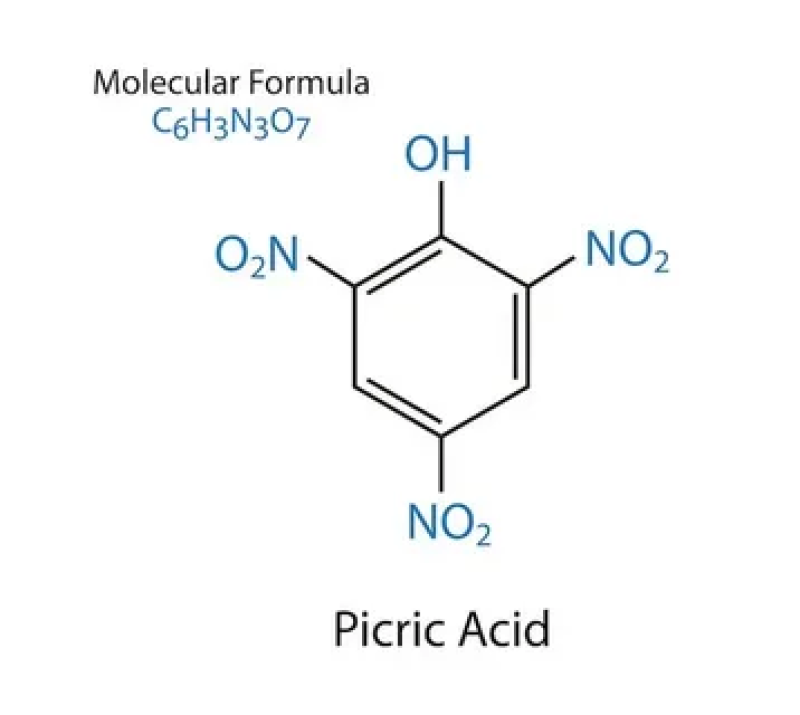Picric acid, also known as 2,4,6-trinitrophenol, is a yellow crystalline solid with significant utility across various industrial, medical, and military sectors. Characterized by its explosive properties and antiseptic nature, picric acid is a chemical compound with a long history, stemming from its initial use as a dye and later transformation into a powerful explosive and chemical reagent. Its multifunctional applications and evolving market demand necessitate a thorough understanding of its production, usage trends, regulatory environment, and commercialization channels.
Chemical Properties and Manufacturing Techniques of Picric Acid
Picric Acid is a nitrated phenol molecule, known mainly for its high reactivity due to the three nitro groups attached to the phenol ring. This structure imparts exceptional explosive characteristics, making picric acid a precursor in the synthesis of military-grade explosives and propellants. The compound is highly soluble in ethanol and ether, moderately soluble in water, and begins to decompose at temperatures above 377°C.
The manufacturing process typically involves the nitration of phenol using nitric acid and sulfuric acid under controlled temperature conditions. This synthesis requires careful handling because of the compound’s sensitivity to heat and shock, which can trigger detonation. Modern production facilities adopt stringent safety protocols to prevent accidental ignition during synthesis, storage, and transportation. The purity of picric acid directly influences its explosive yield and chemical reactivity, demanding extensive quality control in industrial production.
Expanding Industrial Applications Driving Picric Acid Growth
Picric acid’s versatility underpins its broad application spectrum. Historically used as a military explosive during World War I and II, its use has extended into industrial realms due to its antimicrobial and chemical reagent capacities. In the pharmaceutical industry, picric acid plays a role in histology and bacteriology as a staining agent and a component for preparing antiseptic solutions.
Furthermore, picric acid finds use in chemical laboratories for the detection of metals, including gold and palladium, through precipitation reactions owing to its ability to form colored complexes. Its utilization in dyes and photographic chemicals has witnessed a decline but remains significant in specialized chemical processes. The global demand is propelled by emerging uses in advanced materials, such as energetic materials formulation, and synthesis of compounds with enhanced stability and performance.
Regulatory Guidelines and Safety Protocols Impacting Picric Acid Accessibility
Due to its explosive properties and potential toxicity, picric acid is subjected to rigorous regulatory controls globally. Transport regulations classify it as a hazardous material, mandating specific packing, labeling, and handling procedures to prevent accidents during shipment. Occupational safety agencies recommend the use of personal protective equipment (PPE) and strict ventilation standards when working with picric acid to minimize health risks.
Environmental regulations also influence its disposal and waste management, as picric acid can contaminate water bodies and soil if not handled responsibly. These regulatory frameworks affect market availability by limiting manufacturing capacities and increasing operational costs. Companies must navigate these legal landscapes to ensure compliance while maintaining product supply consistency.
End-User Industry Trends Shaping Picric Acid Demand
The picric acid marketplace is segmented based on application, grade (industrial, pharmaceutical, military), and geography. Industrial-grade picric acid accounts for the majority of consumption, primarily in the production of explosives and chemical intermediates. The pharmaceutical-grade segment is witnessing steady growth owing to the rising demand in medical research and clinical diagnostics.
Regionally, Asia Pacific has emerged as a dominant consumer due to expanding industrial activities and increasing defense budgets. North America and Europe maintain significant market shares driven by stringent quality standards and advanced technological adoption. The end-user industries contributing to picric acid demand include defense manufacturing, pharmaceuticals, chemical laboratories, and specialized manufacturing sectors focusing on energetic materials and antimicrobial agents.
Navigating the Picric Acid Industry Through Market Intelligence Reports and Insights
For businesses and stakeholders looking to assess the evolving picric acid industry landscape, detailed market intelligence reports provide in-depth analyses of current trends, competitive scenario, and future outlook. These reports compile critical data on pricing fluctuations, supply chain dynamics, emerging technological advancements, and growth opportunities across different regions.
Accessing such comprehensive reports equips decision-makers with actionable insights to strategize product development, optimize supply networks, and mitigate risks posed by regulatory changes. With market intelligence tailored to the chemical and explosives sector, companies can benchmark their performance and stay ahead in a highly regulated and technologically demanding market environment.
Evolving Commercial Strategies and Trade Dynamics Influencing Picric Acid Transactions
The commercial trajectory of picric acid is influenced by fluctuations in raw material costs, geopolitical factors affecting trade flows, and advancements in alternative chemical compounds. Suppliers and manufacturers adopt diversified procurement strategies to ensure raw material availability, often securing long-term contracts with phenol producers.
International trade of picric acid is subject to export control regulations, and geopolitical tensions can lead to supply chain disruptions. To counterbalance these uncertainties, manufacturers are expanding regional production capabilities and investing in research for safe handling and innovative formulations. Commercial demand is being driven by both traditional explosive uses and novel industrial applications, encouraging market participants to tailor offerings for niche sectors.
Get This Report in Japanese Language: ピクリル酸
Get This Report in Korean Language: 피크릭산
Read More Articles Related to this Industry- The Role of ICC Profiles in Optimizing Color Output with STS Inks
About Author:
Ravina Pandya, Content Writer, has a strong foothold in the market research industry. She specializes in writing well-researched articles from different industries, including food and beverages, information and technology, healthcare, chemical and materials, etc. (https://www.linkedin.com/in/ravina-pandya-1a3984191)
